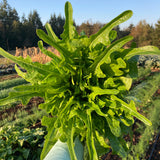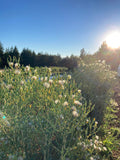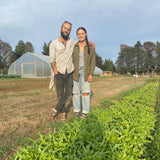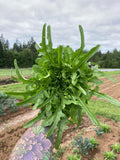Sabatino’s "Peppe Insalata" Lettuce
Lactuca sativa
This light green Italian oakleaf lettuce was grown by Sabatino DiNardo who was born in Gamberale in Abruzzo, Italy and immigrated to the US at the age of 18 in 1956. Sabatino called it "Peppe Insalata" because the seed was given to him by his father-in-law Giuseppe ("Peppe"). It looks quite a bit like the Italian variety called "Lingua di Canarino," or Canary's Tongue. 8-10" rosettes.
Learn more about Sabatino on the Italian Garden Project website here.
This seed is part of the Italian Garden Project’s Italian American Collection. Read about our shared work HERE. Shop for more varieties in this special collection HERE.
This collection represents seeds from the most cherished vegetables of Italian immigrants, those flavors that just couldn't be left behind. Only the best of the best would have been deemed worthy of the passage from the Old World to the New. These are seeds which have been passed down through families for generations, saved from the most vigorous specimens hand-selected each season. When they arrived in America, they were lovingly propagated in backyard gardens and traded as valuable commodities within Italian communities.
Heirloom seeds such as these which have been nurtured over hundreds of years and traveled across continents are at risk of being lost and their histories forgotten. In order to safeguard these treasures, The Italian Garden Project has been seeking out these heirlooms from across the US and serving as their caretaker. And now our partnership with Truelove Seeds and their growers ensures that these unique varieties will continue to flourish and provide the authentic flavors of the past well into the future.
Days to maturity: 50-55
Seeds per pack: 200
Germination rate: 96% on 05/27/2025
Planting / harvesting notes
Seed every 1 inch in rows 8-12 inches apart, 1/4-1/2 inches deep. Keep watered until germination. Thin to every 8 inches. Harvest when you can't wait anymore!
Seed keeping notes
Lettuce is very much self-pollinating, but give at least 10 feet between plants (we give at least 35 feet) to avoid unwanted cross-pollination from flying insects. Allow the plants to bolt and flower. Often, flowering lettuce benefits from simple staking (we tie several plants together) so that the flowers and seedheads do not fall to the ground. Seed is ripe when the flowers turn to 'feathers,' which are fluff balls like dandelions. In the moist summers of Pennsylvania, we harvest the entire seedheads when at least 50% of the plant has gone to seed. If there are dry days in the forecast, feel free to wait longer for more ripe seed. Cut the seedheads a few feet down, and allow to dry about a week in a sunny dry place like a greenhouse, sunny window, or even a car seat. Later, wearing a handkerchief or mask to avoid breathing in the feathers and dust, bang the seedheads in a bucket allowing the seed to fall to the bottom. The ripest seeds fall, the least ripe stay in the plant, so do not over do it. Sift through strainers to remove the large chaff, and then use your breath, a fan, or the wind to carefully blow off the smaller dust.











